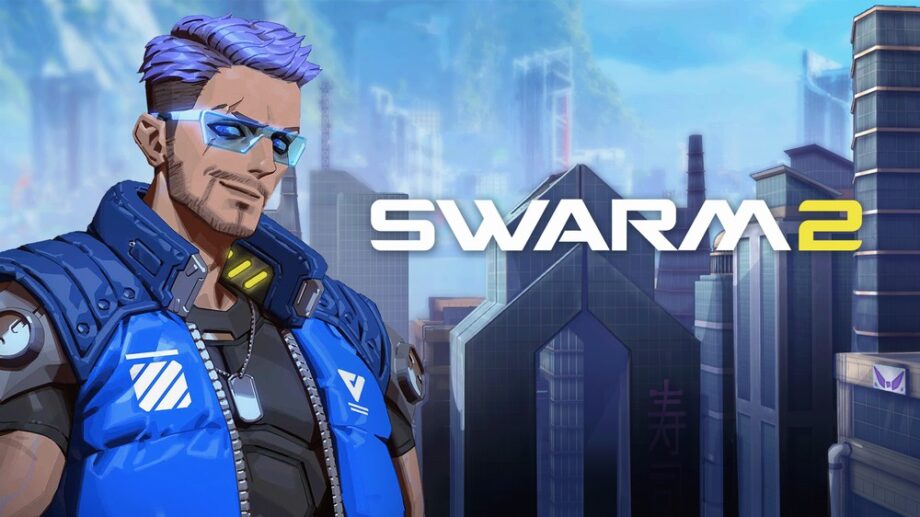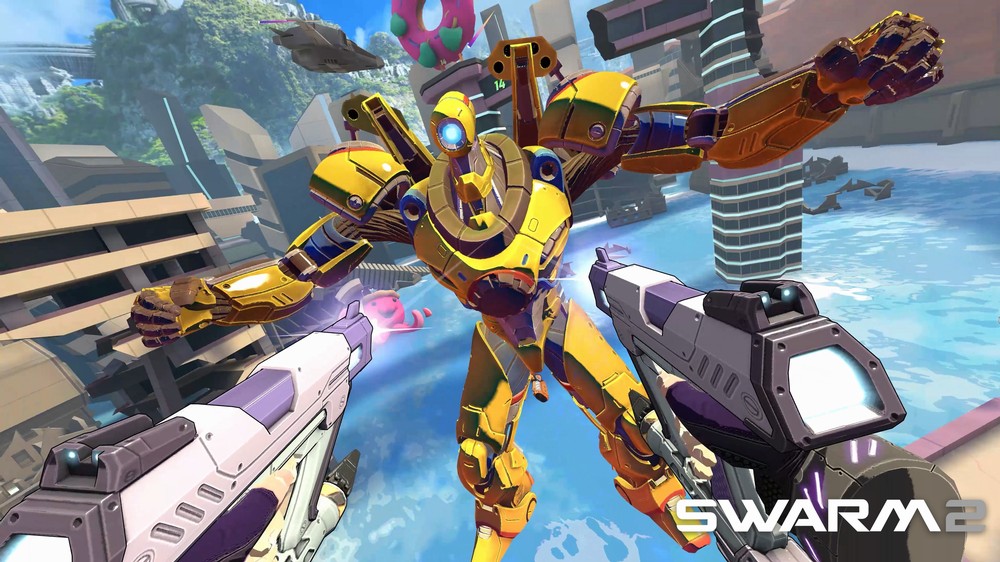As we approach the third anniversary of the original Swarm game, those crafty wizards over at Greensky Games have just released the official sequel, Swarm 2, and with all new environments, game modes, and competitive PvP leaderboard chasing, there is a lot to check out when you dive back into this epic action-shooter. Fans of the original will feel right at home here, as the sequel builds heavily on the skills already learned from the first, but if you are a newcomer to Swarm then the engaging tutorial will show you the basics. Swarm is built upon easily learnable concepts that will take hours of continued gameplay to master and finesse, and all too soon you’ll be traversing these awesome new stages like a teenager who just got bit by a spider.
You’ll be playing as Marv, the last of the grapple commandos, as you slowly (and I mean slowly) progress through the laborious roguelike story mode. This is the biggest update from the first game, adding a deep progression system combined with procedural regeneration so levels are continuously randomized to keep things from getting noticeably repetitive. There are 18 Biomes (stages) divided across three themes (city, desert, space) with five levels and a boss stage for each zone.
Much like any other roguelike you have numerous ways of progression, both long term and for each specific “run”. Completing a level will prompt you with three Perk cards and you can choose one perk to boost various elements like healing, damage, etc. These are stackable over time and can lead to some tremendous abilities later in the run. There is also Shard Tech. These are permanent upgrades you assign to Marv between games by spending Shards, those fancy crystals you collect from your fallen enemies during the game. These stat boosts can also be stacked, with each additional tier costing exponentially more shards while rewarding you with better health, shields, revives, and ability boosts for slow-mo, jetboost, and backstab.
Swarm 2 is generous with its upgrades, and after nearly every game you are given some sort of boost or upgrade or perhaps a new weapon drop that will appear in the next game. The whole experience is this carefully balanced game of difficulty versus ability, and Greensky seems to have found a good balance. My first game lasted 37 seconds, my second was 49 seconds and by the time I was playing my tenth run I was going for multiple stages and lasting upwards of 8-10 minutes. Unless you really have a bad run, it is almost impossible to not do better with each new attempt simply given the nature of the generous reward system. This is a great way to keep morale high and incentivize that “one more try” mentality on a game that could easily have slipped into a repetitive grind.
This new Roguelike mode delivers the core Swarm 2 experience with slow progression that allows you to get just a bit further with each new run, just enough to give you a taste of something new before the game kills you and gives you some new “toys” to hopefully get past whatever just killed you the next time. As mentioned, there are six levels per Biome, four combat levels, a race level, and a boss level, and once you do have the perks and the mastery to complete a full run, it should take just about an hour to complete the game in a single pass. Just know it could take 10-20 hours before you get to that point.
Also new to Swarm 2 is the Arcade mode where you can play levels from the campaign to both practice as well as set new high scores for the competitive PvP leaderboards. This is a great system I have seen used mostly in racing games and some pinball offerings, where you set a new high score and are then notified when somebody beats you and offered an attempt to beat their score to reclaim your throne. To level the playing field, there is no Shard Tech or perks allowed, and everyone has all their abilities unlocked, so this is truly the NASCAR of swinging combat. Or you can turn off enemies and just practice your swinging and movement.
The Challenge mode is back and bigger than ever. This was the most-played mode of the original game and has now been enhanced with bigger levels, more enemies, and infinitely more action. Everyone starts with identical abilities and stats and you all play through the same levels with the same spawns for loot and enemies. The further you go and the longer you survive more enemies start to appear and fewer health and weapon drops occur.
The final new mode is Free Roam, where you are given a much larger city-sized map to explore at your leisure. This is easily the largest and most detailed stage created for a Swarm game, offering countless routes through the city, each with their own unique traversal challenges as well as some signature race events noted by special markers scattered about the city. Just swing through the first 3D icon to start the race then follow the series of checkpoints until finished. Completing each race will earn you a collectible object you can view in the Gallery for additional lore.
Swarm 2 keeps you motivated to keep playing even after you have finished the campaign thanks to its enhanced leaderboards that now have PvP challenges. There are leaderboards for all game modes (except Free Roam) and they can be filtered for global, regional, and friends. Depending on the mode, your score is calculated using a variety of variables, and the new Challenges will notify you when your score has been beaten and offer you the chance to reclaim your spot.
Aside from all that, Swarm 2 plays a lot like the original. There is a new Dash move tied to the right stick that will allow you to laterally move short distances without swinging. Similarly, the new Jet Boost is an unlockable ability that will shoot you upwards. All of these abilities have a great system that requires certain actions during gameplay to keep them charged and ready to use. Zip is a good example. Perhaps the most useful ability of the bunch, Zip allows you to lock-on and rush towards an enemy. You get three of these to start and you’ll need to grapple and kill enemies to keep it filled.
There is a lot of variety in Swarm 2 with 45 possible stages, eight weapons, nearly a dozen enemy robot types including three new turrets; missile, laser, and a mysterious Cube with multiple targets that need to be destroyed before taking down the entire Cube. Some enemies hover in place and take shots at you while others appear from one portal and fly around in formation before exiting through another.
Playing Swarm 2 on the Quest 3 was a remarkable experience. The powerful VR system is able to maintain smooth and reliable framerates with nary a hint of motion sickness, but there are plenty of comfort assists if you need them. Smooth turning was too slow to be competitive, so I went with snap turn and turned on the 180-turn move since you are often swinging past your enemies and need a quick way to flip around and fire.
I had a blast playing Swarm 2. Everything I loved about the first game is back and better than ever, and the new game modes and competitive leaderboards prove that Greensky is listening to their fans and delivering the quality content that we crave. There is already a DLC roadmap that promises new content is coming till the end of 2024, so there has never been a better time than now to grab your guns and grapple your way to victory in a way only VR can offer.
















